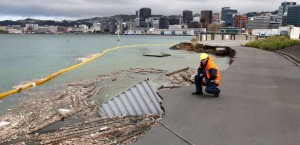Francis Molesworth outlined his vision for the new city of Wellington in 1841 but he wouldn’t recognise the changes nature has wrought and continues to wreak, says Property Council Chief Executive Connal Townsend
By blending 19th century thinking around planning with the inhospitable Wellington terrain, Molesworth came up with a grid configuration centered on a canal running from Thorndon Harbour to a large inland shipping basin.
Then everything changed – the 1855 Wairarapa earthquake dramatically changed the landscape of Wellington and its future development.
The earthquake uplifted the seabed by three metres and on this new land sits the CBD, the road and rail connections to the Hutt Valley and the Basin Reserve.
The Wairarapa Earthquake is only one example of how earthquakes play a substantial role in influencing the form, function and shape of our cities, towns, and communities.
Events over the last few years have shown the devastating impact that earthquakes can have on people and property.
Lessons must be continuously learnt, initiated, and reviewed to reduce the risk of a repeat of the Canterbury earthquake tragedy.
It is therefore encouraging to see MBIE consulting on the regulations and creating a methodology for identifying and managing earthquake-prone buildings.
The 14 November Kaikoura earthquake had a substantial effect on many of the commercial properties in Wellington.
Provisional estimates show 16 buildings and nearly 170,000 square metres of commercial property were affected.
Buildings are and will be demolished over the coming weeks. Tenants will need to find new premises while repairs are undertaken on damaged buildings.
These are short-term issues that will be resolved, but there is a risk that commercial property investment in Wellington may slow as investors weigh up the risk of future earthquakes affecting their portfolios.
Over the last few weeks I have been concerned at the lack of media awareness about buildings and their NBS rating.
Journalists who cover the effect of earthquakes on commercial property have a duty to understand the numerous factors that can cause a building to have damage or structurally fail. This understanding is crucial as they often shape public perception.
I like to use the analogy of an air bag in a car accident when it comes to buildings and earthquakes.
A building in an earthquake, like that of an airbag in a car accident, should protect the people inside. It should also provide a safe means for them to escape after the earthquake. Regardless of the damage, I deem a building to be successful if it achieves these outcomes.
Unfortunately, the media broadly misunderstands this. They seem to assume buildings should withstand earthquakes when the purpose of the legislation is to protect lives.
Damage to infrastructure will be dependent on the nature and strength of an earthquake. While it will be impossible to completely protect vital infrastructure like water and important roading corridors from severe earthquakes, we can focus on providing a high standard of resilience.
The closing of the state highway network will isolate Wellington from the rest of the North Island. However, it is a positive to see significant investment occurring in projects like Transmission Gully and the Petone-Grenada Link.
Resilience required
Whether we like it or not, earthquakes and other natural disasters will strike and often without a lot of warning, our infrastructure must be as resilient as possible to meet the challenges that these events bring.
In light of the Canterbury earthquakes it is positive to see central and local government beginning to develop a broader understanding of the necessity of resilience and a coordinated approach to infrastructure.
As a country, we are susceptible not only to earthquakes, but volcanoes, tsunamis, flooding in cities like Dunedin, and extreme weather events.
These have the potential to severely affect our infrastructure. Resilience must be built into any new capital investment into infrastructure made by either central or local government.
According to Treasury’s 2016 Capital Intentions Plan some $100 billion is forecasted to be spent on infrastructure in New Zealand over the next decade by central and local government.
From roads, railways, schools, hospitals, three waters and more, this is the infrastructure that enables economic growth and social prosperity. But as the price tag shows, this infrastructure is also very expensive.
For too long New Zealand’s ‘number eight wire’ and ‘she’ll be right’ attitude towards infrastructure has impacted economic productivity.
Auckland provides a perfect illustration of this with an incomplete motorway system, a Harbour Bridge that needed the “Nippon Clip-ons” 10 years after first opening, and now a City Rail Link that has possibly compromised its potential through reducing stations and access points. Therefore, we need to have a frank discussion about how we fund infrastructure both now and in the future.
The current system of inter-generational debt exacerbated by funding for development contributions can’t be sustained; we need to be looking at alternatives.
The development sector is willing to pay its share towards infrastructure, but it cannot be relied on or expected to pay more than what is fair.
If councils continue to try to lever more revenue from development contributions, we will have a situation where the housing developments New Zealand needs will become financially unviable.
Future funding
There potentially are a wide range of funding mechanisms available to reflect the differing economic and social realities of our cities, towns, and communities.
One of these is the MUD, or municipal utility district. MUDs are used in Texas with the objective of providing essential infrastructure and services like three waters and roading.
These have been highly successful because they provide opportunities for investing in bonds, enabling housing development and good public policy outcomes.
TIF – or tax incremental financing – is another tool. TIFs are being used successfully across several US cities.
While the case for tax incremental financing is often made for existing suburban areas requiring urban rejuvenation, significant investment in infrastructure or a social policy initiative, cities have started to use it for greenfield suburban expansion.
This funding mechanism has the benefit of clearly identifying the projects that it will fund, thereby providing added transparency and accountability.
I see a lot of merit in using infrastructure bonds, especially if councils linked them to a targeted rate for specific developments.
This approach would provide financing security when councils pay interest and repay the bond to the investor when it matures.
It would also potentially remove the need for development contributions, thereby reducing the upfront costs of new housing.
Altered approach
Once we have established an effective funding mechanism to pay for much-needed infrastructure we then need to address our approach.
In New Zealand, we traditionally develop housing first and then think about the infrastructure needed. We also do not develop housing or infrastructure at a large enough scale.
We have always lacked a big-picture approach to the development of how we build our cities, towns, and communities.
Instead, we develop incrementally, adding bits here and traditionally governments have been reluctant to interfere in the market to any great extent, but this is short-sighted and can lead to poor urban outcomes.
We need to be courageous and change this thinking. Let’s think about infrastructure provision first and then housing.
Central and local government must future-proof development by first protecting and then acquiring land for key infrastructure.
This will signal to the development community that large-scale development can and will occur. By developing at a large scale, we can be thinking about different funding models, such as municipal utility districts, where the costs of infrastructure can be internalised.
By building on a large scale, we can build more resilient networks. Greater Springfield on the outskirts of Brisbane is Australia’s largest master planned city.
When completed, there will be over 120,000 residents with access to a range of economic and social amenities living only a 30-minute train ride away to Brisbane CBD.
Imagine the development potential if we harness an accessible, connected and reliable multi-modal transport approach connecting the North Waikato and Auckland.
We can mix urban rejuvenation of centres like Huntly and Ngaruawahia with newer developments in and around Drury.
This isn’t urban sprawl it’s urban development; I completely support protecting our fragile and sensitive natural environment.
The focus must be on providing high quality, well-designed mixed housing topologies that reflect the changing needs of New Zealanders.
The lessons we can learn from Greater Springfield are clear. We must encourage contiguity in development on an unprecedented scale supporting future-proofed and resilient infrastructure networks, protect the natural environment, better manage urban development spillovers, and provide more localised employment opportunities.
The reality is New Zealand must meet the increasing demand from population and urban growth as well as the challenges and damage that natural disasters like earthquakes can cause.
We need to be bold and look at international best practice more and see how this can be utilised in a New Zealand context.
Property Council will continue to advocate for these types of solutions to increase New Zealand’s economic productivity and social prosperity.



